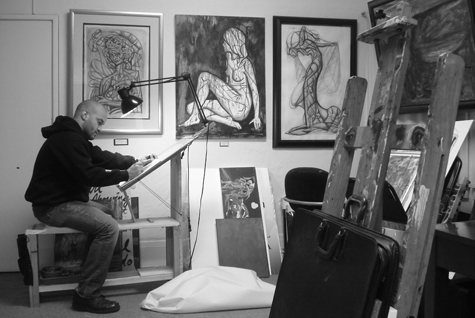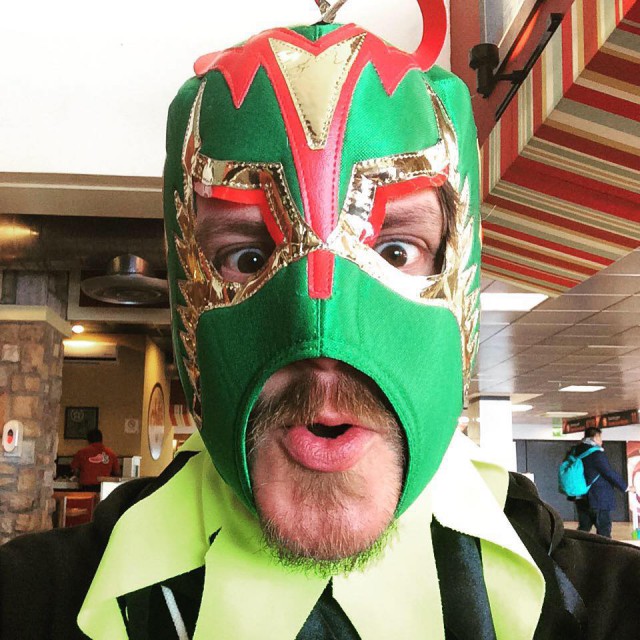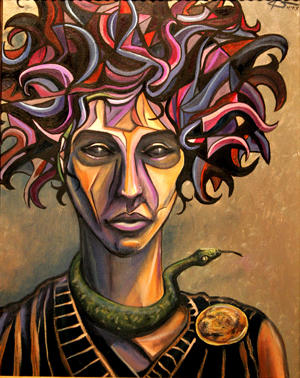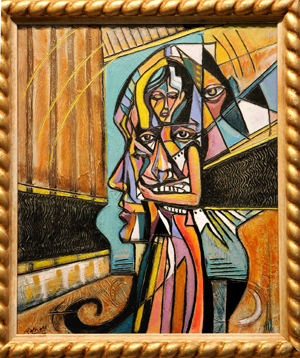 Photo by Michael Collett
Photo by Michael Collett
Raphael Delgado Wears his Heart on his Canvas in New Exhibition
Since opening his art studio in Midtown in August 2006, Raphael Delgado has emerged—humble and prolific—a step ahead of his contemporaries. It could be dangerous to file any explosion of expression under the lead parasol of “renaissance,” but in Delgado’s case, the tag seems more than fitting.
Having been weaned into the burgeoning Sacramento art world by way of guidance from his artist parents, Delgado enjoyed a childhood surrounded by art. Whether it was visiting La Raza Galéria Posada—where his current exhibition, What Is This Thing Called Love? Interpretations by Raphael Delgado began a six-week run on Jan. 22—touring the Crocker Art Museum or attending festivals and galleries in Sacramento, he has suffered the hitches and overcome the throes of becoming a “working artist.”
What Is This Thing Called Love? melds Delgado’s bent for muscular, cubist qualities, adventurous mosaic deconstruction and insistence on spontaneity in the creative process to the overarching theme of love in all its splendorous stages. Pieces such as Crying Couple and New Love both express different types or themes of love.
“New Love is a couple that are at the beginning of a new relationship, in love and in bliss,” explained Delgado. “Crying Couple is a married couple that are going through a hardship, but still together and leaning on each other for support. Both paintings have each couples’ heads leaning toward each other in a heart shape, representing that no matter what stage or theme of love a couple is in, love is still love.”
His exhibition at La Raza is just one more in a series of well-plotted steps—beginning at childhood, through academic study at the Academy of Art in San Francisco—in an exciting and chameleonic evolution as one of the Sacramento area’s best known, and most revered Chicano artists.
Submerge had the chance recently to chat with Delgado about his many muses, his far-reaching approach to his work and his willingness to reveal the cogs of his craft.
Considering that you have the ability to excel artistically within a variety of media, does it hinder you, limit you or change your approach to creating when you are recognized mainly for your cubist work?
I have changed my approach quite a bit, and really started to listen to my collectors’ suggestions. If people are responding to a particular style more than others, then I make an effort to re-create similar paintings and prints in all of the mediums that I am capable. I basically copy myself in other mediums. For example, my angular and distorted cubist portraits are turning up in acrylic, oil, watercolor, gouache, pastel, linocut and woodcut. I would like to say that my clients and viewers are taken seriously when they recommend, “You should make more like that.” Of course, I am still being expressive and artistic, but I am just putting all other ideas on hold, and bringing to life something for which there is real demand. I thoroughly explore and present my popular styles in the front room, but also continue to experiment and be radical in the back.
How big of a role does spontaneity play in your art now compared to when it did, say, when you were in school, or before you attended art school?
In art school, creative spontaneity was a necessity to break up the monotony and strict regimen, and sometimes it even led to an artistic breakthrough. But most of the time my aimless experiments led to improvisation, which led to uncertainty, which oftentimes led to a mess. Looking back, I see the art of young man wanting to be a painter, but not wanting to paint. As a young artist, I rejected the idea of setting out on a painting with a preconceived notion of what I was going to paint.
As I matured and became more grounded in what I was trying to say, I felt that the spontaneity in my drawing was still a useful ally in creating an image that is purely derived from my intuition and my artistic instinct. Also, the distortion and intensity tended to be more passionate and truthful. More recently, armed with a concept and style in mind, I find myself going up to the blank canvas and drawing a purely automatic explosion of quick, bold, decisive outlines. Then, over the course of weeks or months, bringing to life and resurrecting my original idea. My most current work is a delicate balance between pure chaos and careful analysis while still being personally relative. The radiating and intersecting networks of lines can be identified and retraced in almost every painting.
How did the constant inundation of expression while attending the Academy of Art University in San Francisco help to hone your art? Your short film suggests that there was a higher level of competitiveness. Do you feel or react to competition with regard to the creation of your pieces in any medium?
I feel that it is healthy for there to be a competitive nature among artists and teachers. I feel it humbles you and makes you more driven to succeed. Jealousy, self-doubt, rivalry, anxiety and resentment are all feelings that rush over every young artist as they look at other artists’ work. In art school, if I was looking at a painting that I really liked, then chances were very good that I didn’t paint it.
It seemed at the end of every drawing session the crowd collectively chose the best artist by simultaneously circling the easel of the person who made the best work for that day. Surprisingly, the best art is not always the most realistic or fine”¦but sometimes just the most interesting or radical. People wanted to see what you could do differently than the rest of the class.
I have set and maintained a competitive nature in my work ethic, my principles and my business practices to this day. Not that I am the best artist by any means, but you better earn that title. I know I am.
Of what importance is it to you to make sure people who see your work understand it? At what point do you (or do you not) toe the dichotomous line of making art for others and making art for yourself?
I want people to understand my art if they are willing, but more importantly I want people to have a reaction to it. They can love my art or hate it, thinks it’s the best, craziest, or ugliest art they’ve ever seen. If they have an opinion and an emotional response, then I feel I did my job. I want people to understand it, so I try to make myself available for questions. At the same time, I don’t tell them what to think.
What Is This Thing Called Love? Interpretations by Raphael Delgado runs through Feb. 27 at La Raza Galeria Posada (1022 22nd Street). Wednesday, Feb. 3 will feature an Artist Talk with Raphael Delgado, interviewed by Michelle Alexander, Executive Director of the Sacramento Arts & Business Council at 7 p.m. For more info, visit www.larazagaleriaposada.org or artbyraphael.com.




Comments